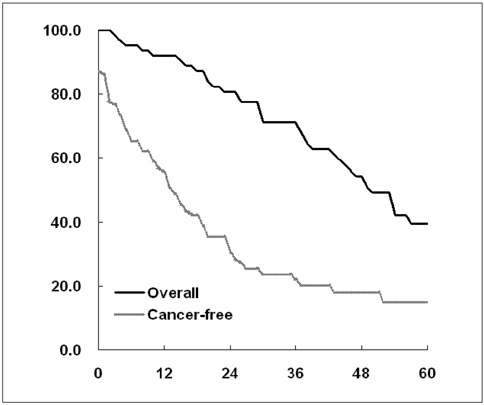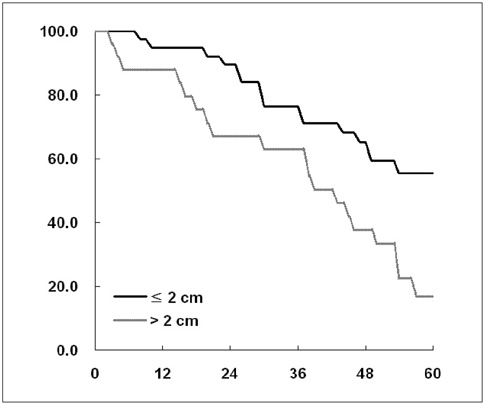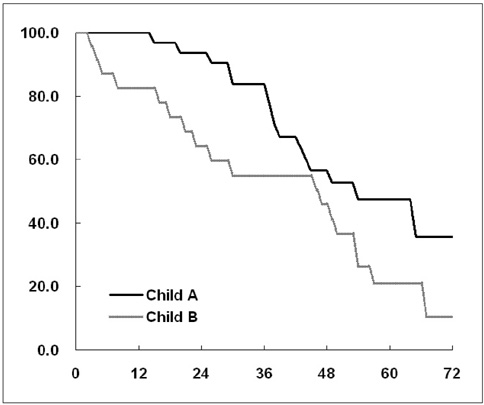Korean J Radiol.
2006 Sep;7(3):187-192. 10.3348/kjr.2006.7.3.187.
Long-term Results of Percutaneous Ethanol Injection for the Treatment of Hepatocellular Carcinoma in Korea
- Affiliations
-
- 1Department of Radiology and Center for Imaging Science, Samsung Medical Center, Sungkyunkwan University School of Medicine, Seoul, Korea. dichoi@smc.samsung.co.kr
- 2Department of Radiology and Center for Imaging Science, Eulji Medical Center, Eulji University School of Medicine, Daejeon, Korea.
- 3Department of Medicine, Samsung Medical Center, Sungkyunkwan University School of Medicine, Seoul, Korea.
- KMID: 1114351
- DOI: http://doi.org/10.3348/kjr.2006.7.3.187
Abstract
OBJECTIVE
To evaluate the long-term follow-up results of percutaneous ethanol injection (PEI) for the treatment of hepatocellular carcinoma (HCC) in Korea. MATERIALS AND METHODS: Sixty-eight nodular HCCs initially detected in 64 patients, were subjected to US-guided PEI as a first-line treatment. Long-term survival rates, local tumor progression rates, and complications were evaluated, as were the influences of tumor size and Child-Pugh class on these variables. RESULTS: No major complications occurred. The overall survival rates of the 64 patients at three and five years were 71% and 39%, and their cancer-free survival rates were 22% and 15%, respectively. The overall survival rate of patients with a small HCC (< or = 2 cm) was significantly higher (p = 0.014) than that of patients with a medium-sized HCC (< or = 2 cm). The overall survival rate of patients with Child-Pugh class A was significantly higher (p = 0.049) than that of patients with Child-Pugh class B. Of 59 cases with no residual tumor, local tumor progression was observed in ablation zones in 18, and this was not found to be significantly influenced by tumor size or Child-Pugh class. CONCLUSION: The results of our investigation of the long-term survival rates of PEI in HCC patients in Korea (a hepatitis B virus-endemic area) were consistent with those reported previously in hepatitis C endemic areas. Patients with a smaller tumor or a better liver function exhibited superior survival rates.
MeSH Terms
-
Treatment Outcome
Survival Rate
Survival Analysis
Risk Factors
Risk Assessment/*methods
Prognosis
Middle Aged
Male
Longitudinal Studies
Liver Neoplasms/*drug therapy/*mortality
Korea/epidemiology
Injections, Subcutaneous
Incidence
Humans
Female
Ethanol/*administration & dosage
Disease-Free Survival
Carcinoma, Hepatocellular/*drug therapy/*mortality
Antineoplastic Agents/administration & dosage
Adult
Figure
Reference
-
1. Bartolozzi C, Lencioni R. Ethanol injection for the treatment of hepatic tumours. Eur Radiol. 1996. 6:682–696.2. Livraghi T, Festi D, Monti F, Salmi A, Vettori C. US-guided percutaneous alcohol injection of small hepatic and abdominal tumors. Radiology. 1986. 161:309–312.3. Shiina S, Yasuda H, Muto H, Tagawa K, Unuma T, Ibukuro K, et al. Percutaneous ethanol injection in the treatment of liver neoplasms. AJR Am J Roentgenol. 1987. 149:949–952.4. Sheu JC, Sung JL, Huang GT, Chen DS, Yang PM, Lai MY, et al. Intratumor injection of absolute ethanol under ultrasound guidance for the treatment of small hepatocellular carcinoma. Hepatogastroenterology. 1987. 34:255–261.5. Livraghi T, Salmi A, Bolondi L, Marin G, Arienti V, Monti F, et al. Small hepatocellular carcinoma: percutaneous alcohol injection-results in 23 patients. Radiology. 1988. 168:313–317.6. Shiina S, Tagawa K, Unuma T, Fujino H, Uta Y, Niwa Y, et al. Percutaneous ethanol injection therapy of hepatocellular carcinoma: analysis of 77 patients. AJR Am J Roentgenol. 1990. 155:1221–1226.7. Ebara M, Ohto M, Sugiura N, Kita K, Yoshikawa M, Okuda K, et al. Percutaneous ethanol injection for the treatment of small hepatocellular carcinoma. Study of 95 patients. J Gastroenterol Hepatol. 1990. 5:616–626.8. Giorgio A, Tarantino L, Francica G, Scala V, Mariniello N, Aloisio T. Percutaneous ethanol injection under sonographic guidance of hepatocellular carcinoma in compensated and decompensated cirrhotic patients. J Ultrasound Med. 1992. 11:587–595.9. Livraghi T, Bolondi L, Lazzaroni S, Marin G, Morabito A, Rapaccini GL, et al. Percutaneous ethanol injection in the treatment of hepatocellular carcinoma in cirrhosis. A study on 207 patients. Cancer. 1992. 69:925–929.10. Livraghi T, Giorgio A, Marin G, Salmi A, de Sio I, Bolondi L, et al. Hepatocellular carcinoma and cirrhosis in 746 patients: long-term results of percutaneous ethanol injection. Radiology. 1995. 197:101–108.11. Lencioni R, Pinto F, Armillotta N, Bassi AM, Moretti M, Di Giulio M, et al. Long-term results of percutaneous ethanol injection therapy for hepatocellular carcinoma in cirrhosis: a European experience. Eur Radiol. 1997. 7:514–519.12. Shiina S, Tagawa K, Niwa Y, Unuma T, Komatsu Y, Yoshiura K, et al. Percutaneous ethanol injection therapy for hepatocellular carcinoma: results in 146 patients. AJR Am J Roentgenol. 1993. 160:1023–1028.13. Castells A, Bruix J, Bru C, Fuster J, Vilana R, Navasa M, et al. Treatment of small hepatocellular carcinoma in cirrhotic patients: a cohort study comparing surgical resection and percutaneous ethanol injection. Hepatology. 1993. 18:1121–1126.14. Kotoh K, Sakai H, Sakamoto S, Nakayama S, Satoh M, Morotomi I, et al. The effect of percutaneous ethanol injection therapy on small solitary hepatocellular carcinoma is comparable to that of hepatectomy. Am J Gastroenterol. 1994. 89:194–198.15. Kang HW, Kim YJ, Kim KM, Kang JM, Kim SH, Kim JH, et al. Efficacy of percutaneous ethanol injection therapy in Korean with hepatocellular carcinoma. Korean J Gastroenterol. 2003. 42:502–509.16. Lin SM, Lin CJ, Lin CC, Hsu CW, Chen YC. Radiofrequency ablation improves prognosis compared with ethanol injection for hepatocellular carcinoma < or = 4 cm. Gastroenterology. 2004. 127:1714–1723.17. Lin SM, Lin CJ, Lin CC, Hsu CW, Chen YC. Randomized controlled trial comparing percutaneous radiofrequency thermal ablation, percutaneous ethanol injection, and percutaneous acetic acid injection to treat hepatocellular carcinoma of 3 cm or less. Gut. 2005. 54:1151–1156.18. Lencioni R, Bartolozzi C, Caramella D, Paolicchi A, Carrai M, Maltinti G, et al. Treatment of small hepatocellular carcinoma with percutaneous ethanol injection. Analysis of prognostic factors in 105 Western patients. Cancer. 1995. 76:1737–1746.19. Seki T, Nonaka T, Kubota Y, Mizuno T, Sameshima Y. Ultrasonically guided percutaneous ethanol injection therapy for hepatocellular carcinoma. Am J Gastroenterol. 1989. 84:1400–1407.20. Tanaka K, Okazaki H, Nakamura S, Endo O, Inoue S, Takamura Y, et al. Hepatocellular carcinoma: treatment with a combination therapy of transcatheter arterial embolization and percutaneous ethanol injection. Radiology. 1991. 179:713–717.21. Shiina S, Tagawa K, Unuma T, Takanashi R, Yoshiura K, Komatsu Y, et al. Percutaneous ethanol injection therapy for hepatocellular carcinoma. A histopathologic study. Cancer. 1991. 68:1524–1530.22. Benvegnu L, Alberti A. Patterns of hepatocellular carcinoma development in hepatitis B virus and hepatitis C virus related cirrhosis. Antiviral Res. 2001. 52:199–207.23. Chen TH, Tseng LM, Chau GY, Lui WY, Tsay SH, King KL, et al. Clinicopathologic and prognostic differences between patients with hepatitis B- and C-related resectable hepatocellular carcinoma. J Formos Med Assoc. 2001. 100:443–448.24. Yamamoto J, Okada S, Shimada K, Okusaka T, Yamasaki S, Ueno H, et al. Treatment strategy for small hepatocellular carcinoma: comparison of long-term results after percutaneous ethanol injection therapy and surgical resection. Hepatology. 2001. 34:707–713.25. Llovet JM, Fuster J, Bruix J. Intention-to-treat analysis of surgical treatment for early hepatocellular carcinoma: resection versus transplantation. Hepatology. 1999. 30:1434–1440.26. Fong Y, Sun RL, Jarnagin W, Blumgart LH. An analysis of 412 cases of hepatocellular carcinoma at a Western center. Ann Surg. 1999. 229:790–800.27. Wayne JD, Lauwers GY, Ikai I, Dohery DA, Belghiti J, Yamaoka Y, et al. Preoperative predictors of survival after resection of small hepatocellular carcinomas. Ann Surg. 2002. 235:722–731.28. Khan KN, Nakata K, Kusumoto Y, Shima M, Ishii N, Koji T, et al. Evaluation of nontumorous tissue damage by transcatheter arterial embolization for hepatocellular carcinoma. Cancer Res. 1991. 51:5667–5671.29. Nishizaki T, Takenaka K, Yoshida K, Ikeda T, Sugimachi K. Influence of lipiodolization on a cirrhotic liver. J Surg Oncol. 1995. 58:263–268.30. Uchida H, Ohishi H, Matsuo N, Nishimine K, Ohue S, Nishimura Y, et al. Transcatheter hepatic segmental arterial embolization using lipiodol mixed with an anticancer drug and Gelfoam particles for hepatocellular carcinoma. Cardiovasc Intervent Radiol. 1990. 13:140–145.31. Matsuo N, Uchida H, Nishimine K, Soda S, Oshima M, Nakano H, et al. Segmental transcatheter hepatic artery chemoembolization with iodized oil for hepatocellular carcinoma: antitumor effect and influence on normal tissue. J Vasc Interv Radiol. 1993. 4:543–549.32. Matsui O, Kadoya M, Yoshikawa J, Gabata T, Arai K, Demachi H, et al. Small hepatocellular carcinoma: treatment with subsegmental transcatheter arterial embolization. Radiology. 1993. 188:79–83.33. Khan KN, Yatsuhashi H, Yamasaki K, Yamasaki M, Inoue O, Koga M, et al. Prospective analysis of risk factors for early intrahepatic recurrence of hepatocellular carcinoma following ethanol injection. J Hepatol. 2000. 32:269–278.34. Koda M, Murawaki Y, Mitsuda A, Ohyama K, Horie Y, Suou T, et al. Predictive factors for intrahepatic recurrence after percutaneous ethanol injection therapy for small hepatocellular carcinoma. Cancer. 2000. 88:529–537.35. Belghiti J, Panis Y, Farges O, Benhamou JP, Fekete F. Intrahepatic recurrence after resection of hepatocellular carcinoma complicating cirrhosis. Ann Surg. 1991. 214:114–117.36. Nagasue N, Yukaya H, Ogawa Y, Sasaki Y, Chang YC, Niimi K. Clinical experience with 118 hepatic resections for hepatocellular carcinoma. Surgery. 1986. 99:694–701.37. Livraghi T, Goldberg SN, Lazzaroni S, Meloni F, Solbiati L, Gazelle GS. Small hepatocellular carcinoma: treatment with radio-frequency ablation versus ethanol injection. Radiology. 1999. 210:655–661.38. Lim HK. Radiofrequency thermal ablation of hepatocellular carcinomas. Korean J Radiol. 2000. 1:175–184.39. McGhana JP, Dodd GD 3rd. Radiofrequency ablation of the liver: current status. AJR Am J Roentgenol. 2001. 176:3–16.40. Lencioni RA, Allgaier HP, Cioni D, Olschewski M, Deibert P, Crocetti L, et al. Small hepatocellular carcinoma in cirrhosis: randomized comparison of radio-frequency thermal ablation versus percutaneous ethanol injection. Radiology. 2003. 228:235–240.
- Full Text Links
- Actions
-
Cited
- CITED
-
- Close
- Share
- Similar articles
-
- Interventional Treatment of Hepatocellular Carcinoma; Transcatheter Arterial Chemoembolization and Percutaneous Ethanol Injection
- A Case of Needle Tract Seeding of Hepatocellular Carcinoma after Percutaneous Ethanol Injection Therapy; Needle Tract Seeding after Percutaneous Ethanol Injection Therapy
- Is Percutaneous Ethanol Injection Therapy Still Effective for Hepatocellular Carcinoma in the Era of Radiofrequency Ablation?
- Three Cases of Small Hepatocellular Carcinoma Treated with Percutaneous Microwave Coagulation Therapy
- Icteric Type Hepatocelluar Carcinoma for Which Cholangioscopic Ethanol Injection Was Effective




